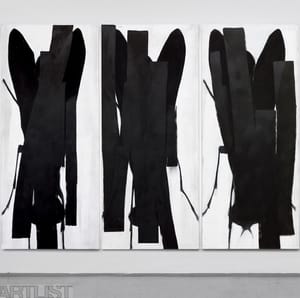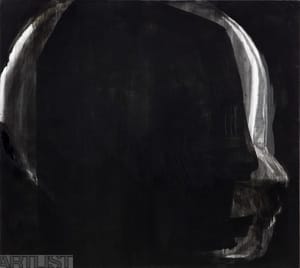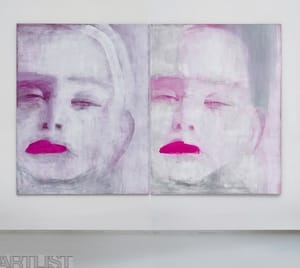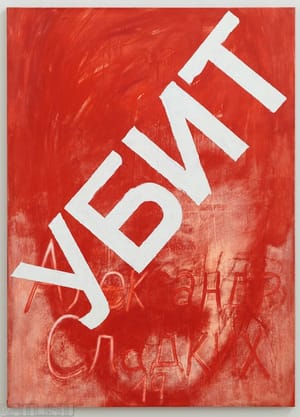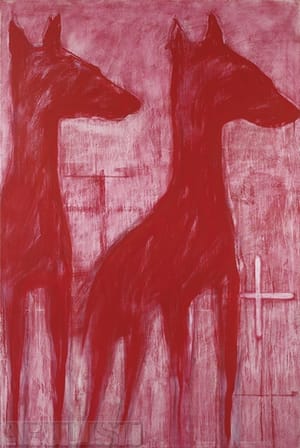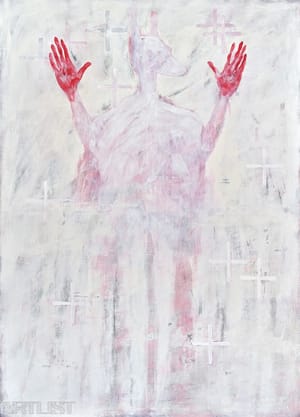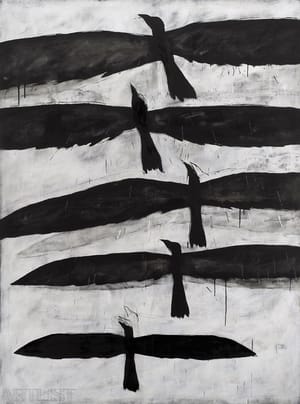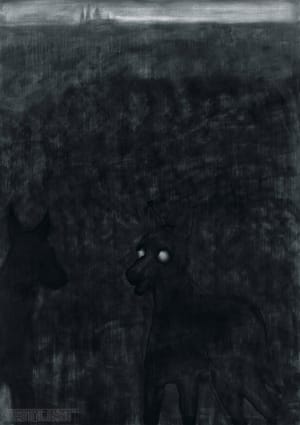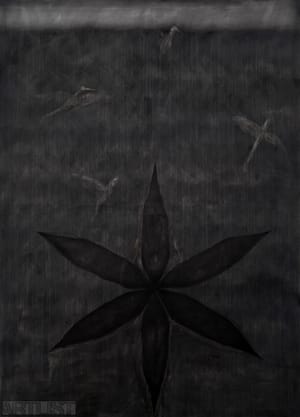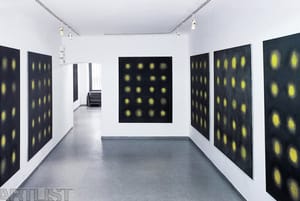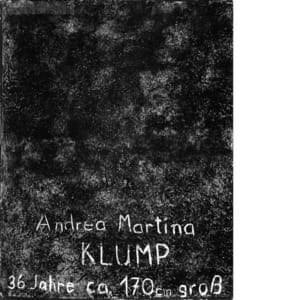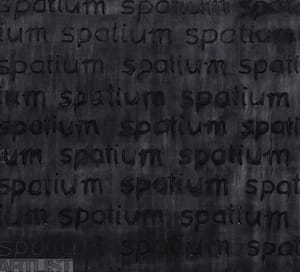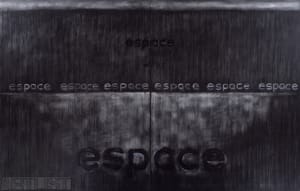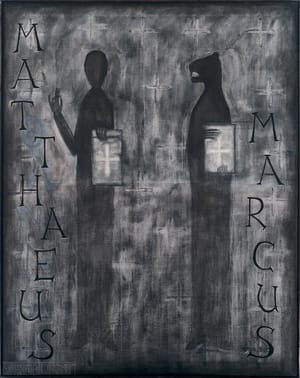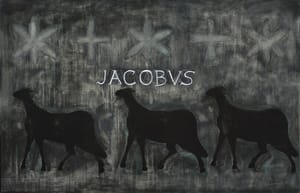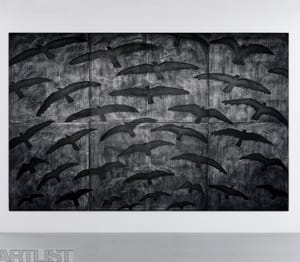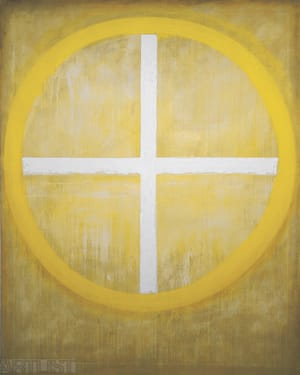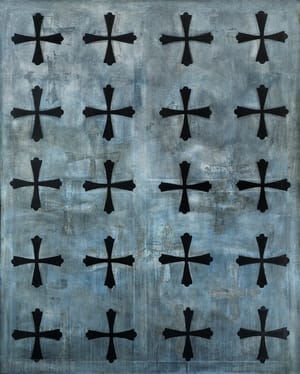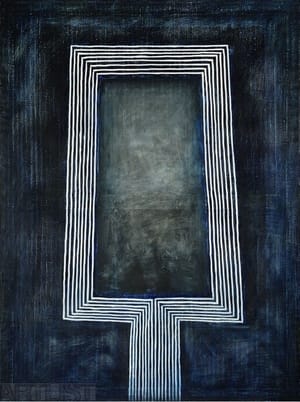- First Name
- Josef
- Surname
- Žáček
- Born
- 1951
- Birth place
- Praha
- Place of work
- Praha
- CSU Library
- ↳ Find in the catalogue
About artist
What pictures of evangelists, dogs and lemmings have in common with portraits of those who are called terrorists might be expressed with the word uncertainty. This term, however, loses its negativity once we realise that everything to which we ascribe the character of certainty is such thanks to the firm coherence of human cognitive constructs. Their certainty is proved by the fact that the construction fits together and works. What kind of proof is that, however? The symbolic value of the sign of the cross unlocks the door to the secret of human co-existence, but also serves as a neutral sign, which can be used for the benefit of this or that arbitrariness. How can a cross be painted so that it is a key to the secret of the human world and not just a tool for someone’s power?
The court sentenced the R.A.F. members as terrorists on the basis of certain legal constructions. Doubts about these constructions are raised by the circumstances of arrest, imprisonment and the very process itself, as well as by the causes of the whole “terrorist” activity, which lie in the opaque reality of institutionalized violence. A “higher” justice that would draw aside the veil of human constructs is not available to man. What we are left with is an uncertainty justifying deep tolerance and the desire for truth. It is this uncertainty that Josef Žáček paints. […]
Žáček’s artistic stance is that of a resolute but rather complex relation towards the current artistic world. In fact he does not differ much from contemporary painters on the world stage. Rather the contrary: his radicalness is nothing else than the basic tendency of the development of art in the last two centuries, to provide an alternative to thinking, whose main, if not only, goal is to control reality so that it serves our needs and set goals, which immediately raises the question who is included under “our”. The radicalness of Žáček’s painting is not reflected in the way of painting as it is in its total lack of care about what institutions should do about his works. Žáček not only does not care about current trends, as Jirous pointed out, he does not care where his paintings end up. The distribution of Žáček’s work will no doubt meet serious problems due to scale, numerous cycles and even socially controversial issues (Who will put upon their walls a picture of R.A.F. members, of Seaside partisans). “The paintings of Josef Žáček are not of this world” (M. I. Jirous) and there is no place ready for them in this world.
This fact, however, is significant for the character of Žáček’s work: its social and political contexts, paradoxically, leads to the fact that these works are not acceptable by social institutions. The content of the concept of art goes far beyond the “world of art”, as it was understood by Arthur Danto (Arthur Danto, Artworld. Journal of Philosophy 1964, no. 61, p. 541, Czech translation Aluze 2009, no. 1).
If we call it the “art industry” today, then Žáček’s work does not belong into this context, not just because of the above mentioned “problems” (scale and topics), but in principle. Art as industry is, in a way, a justifiable unity of individual and institutional activities, while Žáček’s work focuses on problematizing the institution as such. Not that institutions are his enemies. He just sees too clearly that any institution created by man approaches the sensitive events of human cohabitation inadequately and abstracts them into a form required by the technical means of communication. If institutions are characterised by being controlled by generally set rules, then even the language is an institution. Even the language, if it is to be communicated, must have its rules, albeit these rules will always be in opposition to the uniqueness of the artist’s intention and invention.
Žáček’s painting language is a pronounced expression of this tension that casts doubt on any formation, any effort to incarnate the signified into a generally acceptable form of the signifier, to transform a live idea into a sign bound with the content. It is the vibrating adventure in the background of his paintings that by repeated washing of the traces of the brush and new drawing interventions creates a field of signs that are not yet born – the painter uses the word “foetus”. Similarly, the figures of his paintings that refer to cultural contexts and, at the same time, undermine their institutionalized form or draw attention to social events, by implicitly demonstrating the tragic lack of maturity in people who appear in them on both sides.
In: Josef Žáček, Anticorps, GHMP, Praha 2017 (extract from the text Žáček’s Stubborn Uncertainty)
- Author of the annotation
- Ludvík Hlaváček
- Published
- 2017
The setting sun, darkness and daybreak and through the daylight an awakening which in which there is a glimmer of hope.
A path lost in the darkness over which the wind blows, and you hear his voice, but you don’t know where from and where it is heading.
Josef Žáček’s paintings are religious. In contemporary painting, following the cruel postmodern epoch, anything apparently goes. Even if it means it is no longer painting. This is not Žáček’s case.
With a strange quiet and a collected intensity, not disdainful but not overly concerned with contemporary trends, Žáček paints birds, lambs, imaginary portraits of the disciples, imaginary portraits of spiritual warriors against globalisation or levelling down, if you will, and the flowers of Apate, the goddess of deceit.
Contemporary Czech painters surprisingly have no link with Czech gothic art. It is as though god disappeared somewhere, as though the pursuit of deceitful values overcame and destroyed loyalty, virtue, faith, hope and love.
Žáček portrays those who destroyed these values as beasts of prey: darkly in a dark darkness, with bare eyes from which horror emanates. At the other end of the spiritual spectrum are transcendental pictures of birds filling the sky of our hope. There are also imaginary portraits of pure people, so-called terrorists: faces melted in a network so fine that it could not be finer. The broken structure of the old world in whose networks are caught those who tried to change it.
Žáček is the gothic painter of the modern period. He composes his pictures in order to be closer to god. Neither postmodern nor avant-garde, but collected work in the vineyard of the Lord. His birds are symbols of anything, angels perhaps, that takes us above our miserable terrestrial wandering.
Like Mikuláš Medek and Robert Piesen Žáček is a painter of internal spirituality. He moderated his painting to almost monochrome, he focuses the attention and perception of the observer to the interior of the picture, beyond its iconographic surface. Nevertheless, it is extremely important what painting clings to that surface. The symbol is nothing in itself if it does not stimulate in us an interest to understand it.
However, Josef Žáček is an existential painter and not an illustrator of ideas or an apologist for faith and hope. These are located more deeply, paradoxically just under the thinly painted canvas.
And as far as perceptions of Žáček’s are concerned, Oscar Wilde wrote in his preface to The Picture of Dorian Gray: “All art is at once surface and symbol. Those who go beneath the surface do so at their peril. Those who read the symbol do so at their peril.”
In: České ateliéry / Czech studios (71 umělců současnosti / 71 contemporary artists ), Art CZ, Praha 2015
- Author of the annotation
- Ivan M. Jirous
- Published
- 2004
CV
Studies:
1977–1983 Academy of Fine Arts, Prague, Oldřich Oplt
Exhibitions
- Solo exhibitions
-
2011
Josef Žáček: Šepoty, DOX, Centrum současného umění / Centre for Contemporary Art, Praha 7
Josef Žáček: Krajina, Výstavní síň Sokolská 26, Ostrava
2010
Praha, Galerie NoD, (s Jankou Vidovou)
Brno, Galerie Aspekt, Diptich, Triptych
2009
Šumperk, Galerie Jiřího Jílka, Malba (katalog, text Miroslav Koval)
2008
Kutná Hora, Galerie Felixe Jeneweina, cyklus Krajina (katalog, trext Richad Drury)
Louny, Vrchlického divadlo, Obrazy z posledních let
2007
Litoměřice, Severočeská galerie výtvarného umění, cyklus Sen o Apokalypse (katalog, text Eva Neumannová)
Praha, Galerie Woxart
Brno, Galerie Aspekt
2006
Praha, Galerie Via Art, cyklus Oltář snů
2005
Brno, Galerie Na skleněné louce, Obrazy
2004
Praha, Galerie kritiků, palác Adria, cyklus Genius loci
2003
Brno, Galerie Aspekt
Brno, Galerie Na skleněné louce, Obrazy z roku 1993
2002
Praha, Galerie Behémót, cyklus Oči velkoměsta
Klatovy, Muzeum a galerie Klatovy/Klenová, Galerie U bílého jednorožce
2001
Praha, Galerie Behémót, cyklus Sedmý smysl těla
1999
Praha, Galerie Bayer and Bayer, cyklus Apaté
1997
Praha, Galerie Behémót, cyklus Vesmír
Praha, Karlovy Vary, Artforum
1995
Praha,Galerie hl.m. Prahy,cyklus Až budou lumíci létat
Veselí na Moravě, Galerie ve dvoře
1994
Praha,Galerie Behémót, cyklus Portréty – hledání ve ztraceném prostoru (katalog, text Magdalena Juříková)
Karlovy Vary, Artforum
1993
Brno, Galerie Aspekt, Obrazy
1992
Praha, Nová síň, cyklus Pastýři a Nebeští ptáci
Berlín, Galerie 2G, Gegenwart
Praha, Galerie Behémót, cyklus Evangelisté a Zahrada psů
Bonn, Beuel Süd, NachtfolgeChristiKirche
1991
Praha, výstavní síň Forum
1990
Olomouc, Galerie Půda (s P. Zajíčkem a D. Němcem)
1989
Praha, Galerie Mladých, cyklus obrazů Podle Evangelia Sv. Matouše
1987
Praha, výstava na půdě
1986
Praha, výstavní síň v knihkupectví
- Group exhibitions not included in ARTLIST.
-
2010-2011
Dialog 21, Galerie Califia, Horažďovice
1984-1995: Česká malba generace 80. let, Wannieck Gallery, Brno
2007
Typický obraz, Galerie Nová síň, Praha
2004
Světlo rozumu - světlo víry, Galerie Konzum, Brandýs nad Orlicí
Ejhle světlo / Look Light, Jízdárna Pražského hradu, Praha
2003
Typický obraz, Чешcкий центр Москва (České centrum Moskva), Moskva (Moscow)
Ejhle světlo / Look Light, Moravská galerie v Brně, Brno
Speculare, Galerie Konzum, Brandýs nad Orlicí
Svět jako struktura, Struktura jako obraz, Galerie U Bílého jednorožce, Klatovy
2000
Praha, Galerie VIA ART, VIA 2000
Praha, Mánes, TRANS GLOBE
1999
Josef Žáček: Apaté, Galerie Bayer & Bayer, Mostecká 16, Praha
1997
Praha, České muzeum výtvarného umění, Ouplná lůna
1996
Praha, Valdštejnská jízdárna, FINEART ´96
1995
Praha, České muzeum moderního umění, České výtvarné umění 20. století
1993
Praha, Jízdárna Pražského hradu, Rada galerií, Záznam nejrozmanitějších faktorů…
Brno, Moravská galerie / Praha, Národní galerie, Příběhy bez konce
Klatovy / Klenová, Muzeum a galerie, Šedá cihla
1992
Sevilla, EXPO 92, Pavilon umění, Světlo a duch
Praha, České muzeum výtvarného umění, České moderní umění
Praha, Národní galerie, Reklama na nekonečno
Praha, Středoevropská galerie, Inovace
1991
Praha. Výstavní síň Mladá fronta, Proti zdi
Praha, Emauzy, Hořící keř
1990
Rotterdam, Mladá evropská malba
Los Angeles, Otis Parrsons Gallery, Dialog Praha-Los Angeles
Lisabon, Mother of Water Gallery, Mladí umělci z Prahy
1989
Praha, Dům barikádníků, K ROK 89
Praha, Lidový dům, Dialog Praha-Los Angeles
Praha, Holešovická tržnice, Mladá malba a plastika
Wroclaw, Československo: Mladí umělci
Praha, Galerie hl.m. Prahy, Solidarita se studenty
Praha, Vinohradská tržnice, Otevřený dialog
1988
Moskva, Malba generace 80. let
Praha, Galerie hl.m. Prahy, Výstava Patnácti
- Collections
- Národní galerie v Praze, České muzeum výtvarných umění v Praze, Galerie výtvarného umění v Roudnici nad Labem, Severočeská galerie výtvarného umění v Litoměřicích, Východočeská galerie v Pardubicích, WOXART s.r.o. Praha, Komerční banka and various collections in the Czech Republic and abroad.
Monography
- Monography
Josef Žáček, 90. léta, Edice galerie Behémót III. Praha 2002. Texty: Petr Rezek, Ivan M. Jirous, Milan Kozelka, Marcela Pánková, Antonín Kosík, Vlasta Čiháková-Noshiro Josef Žáček, Brno, Galerie Aspekt, 2010 (text: Richard Drury, Ivan M. Jirous, Milan Kozelka, Jiří Machalický)
- Articles
Jiří Machalický, Malířův působivě zanikající svět, Lidové noviny 15/3/07
Radan Wágner, Sen o apokalypse, A2, kulturní týdeník 14/3/07
